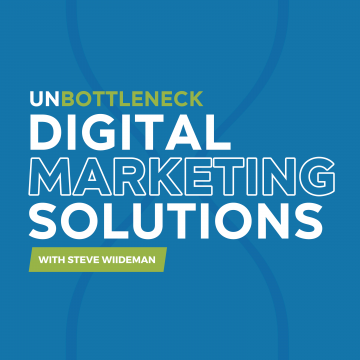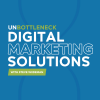Podcast: Play in new window | Download
If you’re a business owner with 2 or more locations and you’re struggling to effectively scale and manage your search marketing strategy, this episode will be your saving grace! In this episode of the Unbottleneck Podcast, Steve Wiideman is joined by digital marketing expert, Marshall Nyman, for a deep dive into scaling content for multi location businesses.
About Our Guest: Marshall Nyman
Marshall Nyman lives and breathes multi-location brands. As a former senior digital marketing manager for Dine Brands, he helped revamp local search strategies for national brands such as Applebees and IHOP.
Nyman is currently an Account Director at Rio Seo and he is here to share some awesome tips and best practices for businesses to win with hyperlocal content.
He is also founder of Nymo & Co where he helps e-commerce businesses grow their online brand.
Sponsored by Ryte
Featured in this episode:
- The Challenges of Large and National Brands
- Data Accuracy
- Scaling Content for Local Pages
- Hyperlocal Content Considerations
- Don’t Let Reviews Hold You Up
- How to Respond to Negative Review
National Brand Challenges
Managing several business locations is a challenge because so much data and information must be maintained and updated on an ongoing basis. Big brands often have multiple franchise groups to manage these locations which require strong communication.
Small brands, on the other hand, are at an advantage because they can easily submit their own business information without having to go through too many checks and balances. They also have a local advantage because they are able to create and foster a more personable relationship with other local businesses — a task much more difficult for large brands.
Data Accuracy
Your business details are the most important attributes to rank in Google Maps other than proximity. Your information needs to be accurate and consistent across all online databases. Having the most accurate information will help mitigate negative reviews by preventing confusion and inconvenience.
Here a sample of attributes that must be accurate:
- Business Name
- Address
- Phone Number
- Hours
- Website
Here are the most popular online directories to consider listing your business:
- Google My Business
- Bing Local
- Apple Maps
- Tripadvisor
- Next Door
- Yelp
Scaling Content for Local Pages
It’s much harder to write unique content when you have hundreds or even thousands of locations. The best way to scale content is to get the right people in the right areas. Consider hiring someone who is familiar with the local area that can call out important details that someone outside of that location might miss.
Not only will you need someone who is familiar with a specific location, but they need to understand SEO and the factors that can help these pages rank such as:
- Driving directions
- Unique Photos
- Hours of Operation
- Open Now Tag
- Coupon / Offers
- Maps
- 360 Video of Location
Many of these factors require a great deal of time and effort, but a study conducted by Wiideman Consulting Group showed that integrating these components in your business listing can increase your chances of ranking by 107%!
Hyperlocal Content: What’s Happening?
When creating hyperlocal content for each of your locations, you will need to ask yourself two questions:
What’s happening in my physical location? The unique features inside your physical location can set you apart from other locations within the brand such as televisions, happy hour specials, family night or even a drive-thru.
What’s happening outside of your physical location? To hone in on your local advantage, call out your surrounding areas that are general landmarks such as shopping centers, hospitals, stadiums, or schools.
Don’t Wait for Reviews
If you’re considering opening a second business location, don’t wait until you open to generate hype! Online presence is going to be a huge factor in attracting new people, therefore, you’ll want to get your listing up and running ahead of time to start on the right foot.
A great way to start getting reviews for your new location is to have a pre opening event or a soft launch and get your first 5-start ratings. Many of these people may be friends and family, but it’s worth it to get the ball rolling!
Pro-Tip: If you don’t want to directly ask customers for a review, offer a check-in special or request to leave photos on your listing.
How to Respond to Negative Reviews
No one wants a negative business review. A bad review can be a deal-breaker for potential customers or clients who come across your business listing online. However, the deciding factor could rest on the business owner’s response.
While negative feedback can sometimes feel like a personal attack, it’s important to understand that how you respond goes a long way.
Here are some helpful tips that should help guide your response:
- Do not downplay the issue
- Acknowledge what the problem was
- Show empathy for the situation
- Make an effort to resolve the issue in an agreeable manner
Don’t ignore negative reviews. Take the negative reviews seriously and use them to implement new policies and procedures to avoid similar issues from happening in the future.
Pro-Tip: Talk like a person and not a brand. Do not copy and paste a generic response. Instead, add a personal touch by addressing the issue specifically and showing that you understand the breakdown that happened in communication, policy or procedure.
Keep up with the best local SEO and digital marketing strategies. Follow Steve on LinkedIn!




